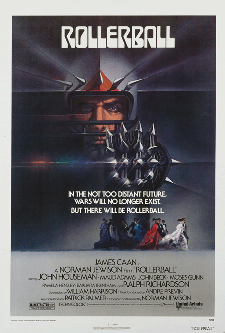Many professors use films to illustrate key points in class or to support class materials. One of us annually shows YouTube clips from the 1975 movie classic “Rollerball,” and we wince every time we’re obligated to watch director Norman Jewison imagining a more violent future for global sports. He didn’t do it with human hunting (ala Richard Connell’s “The Most Dangerous Game”) but rather chose to place actor James Caan and others in football helmets and then made them chase each other around a banked oval on roller skates (or via motorcycles with grab rails).
At the end of the movie (spoiler alert here), the Rollerball world championship is conducted with no rules and no time limit. Essentially everyone but Caan dies. It wasn’t the best screenplay ever but the point behind violence in sports was clearly made: Win at all costs.
In thinking about this issue, we looked back and acknowledged the violence component was easy for the executive producers to pitch in Hollywood 40 years ago. It was the year of shock value and hits like “Jaws,” “Death Race 2000,” “Dog Day Afternoon,” “The Ultimate Warrior” and “Texas Chainsaw Massacre” (released in October 1974) populated the cinematic landscape. So, yes, there was a time when our culture thought violence (just like sex) sold. Many would suggest it still does.
But roller skates? Seriously?
Still, we were forced to salute Jewison’s projection of a global sports league in 2018 (the suggested date of the movie), where Houston might play Madrid or Tokyo. And while it might have been nothing more than a one-off movie about the future, it reflected feelings some futurists held for sports as the 1970s hit their midpoint.
So flash forward to the final exam for this particular class. Undergraduate college students are asked to extrapolate from course materials (including Nicholas Negroponte’s brilliant book “Being Digital”) and predict the future triangulation of sports, media and society. Having spent a semester debating concepts and realities such as Oculus Rift, DraftKings, “Madden NFL 2015” (or “NBA 2K ’15”), Spike Jonze’s movie “Her,” the UFC and CBS’s “Survivor” (or Discovery Channel’s “Naked and Afraid”), they are asked: “Forty years from now, what does sport in 2055 look like?”
 |
|
 |
The 1975 movie “Rollerball” envisioned a violent sports world in 2018. For today’s students, virtual reality is the key.
Photo by: GETTY IMAGES
|
Not an easy question for any of us.
Not surprisingly, many student answers projected significant growth in virtual and augmented reality. They could easily forecast the linkage between video games, fantasy sports, you-are-there graphics and player immersion (via teleportation). One young man wrote that sports in the middle of the 21st century “may include competition between teams that compete in virtual reality settings where pro clubs violently battle in a world that isn’t actually real. The virtual reality piece allows for different locations, teams and many other variables that we [the viewer] can control.”
The students already knew the new release of a video game can dwarf the revenue generated from a mainstream movie. “Grand Theft Auto V” reportedly reached $1 billion in sales in three days and “Call of Duty: Black Ops III” (set in 2065 and scheduled to be released Nov. 6) more than likely will surpass $2 billion this coming holiday season.
We understand that many in the sports industry don’t think video games actually constitute “real” sports. And they shake their heads when they hear about professional gamers leveraging the digital universe and securing lucrative contracts from South Korean companies like LG and Samsung. We understand that DraftKings’ market value a few months ago was roughly $900 million and that fantasy leagues will soon generate more than $5 billion annually in a spider web of reported and unreported cash flows.
Interestingly, in June, we started to get a glimpse of the future when leading sport management agency IMG announced its movement into eSports to focus on digital marketing and endorsement opportunities. Such a move by IMG signals a change in the sports industry, and while parent WME is not likely to abandon its bread and butter in talent representation, the old Boston Consulting Group marketing matrix for portfolio management (often called a “consultant’s best friend”) would suggest the “cash cows” of today are headed to “dogtown” and the “question marks” of yesterday will become the “stars” of tomorrow.
Frankly, we’re not surprised. We hear this question about portfolio (or segment) growth on a weekly basis. Things are changing. Fast and furiously. The growing players now share content. They don’t own it (think Google and Airbnb). And they cross-promote, cross-collaborate and cross-pollinate.
We’ve put forth answers to the media about fans wanting to experience sports from the comfort of their homes but expecting to be teleported into the middle of the offensive line in a football game, the scrum of a rugby contest or Centre Court at Wimbledon. They want to get down into the blocks just before the start of the Olympic final for the 100-meter dash.
James Caan might have been wearing a football helmet for a movie made in 1975 about 2018. The NFL was ascendant at that time and Hollywood had already produced “The Longest Yard (1974)” and soon would offer up “Black Sunday (1977)” and “North Dallas Forty (1979).” Football was a safe bet and America’s disposable income would pour into NFL coffers for the next 40 years.
Today, though, we think you might want to quiz the young men and women entering your company at the lowest level. They might not have your Rolodex (or BlackBerry, iPad or Galaxy) but they might hold insight on questions you should start asking.
Rick Burton (rhburton@syr.edu) is the David Falk Professor of Sport Management at Syracuse University. Norm O’Reilly (oreillyn@ohio.edu) is the Richard P. & Joan S. Fox Professor of Business and chair of the Department of Sports Administration at Ohio University.
IT’S YOUR TURN TO SPEAK OUT
For more information on guest columns in Street & Smith’s SportsBusiness Journal, please contact Betty Gomes at (704) 973-1439 or bgomes@sportsbusinessjournal.com.






